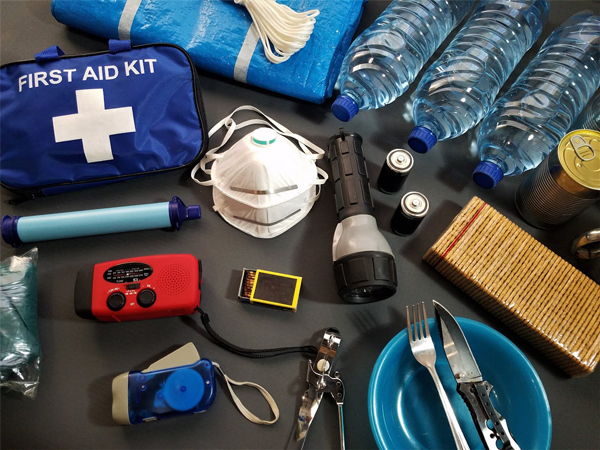Imagine waking up to the sound of warning sirens, or watching wildfires approach your neighborhood on the news. Would you know what to do next?
Climate-related disasters across the United States are becoming more frequent and intense. In fact, the number of U.S. weather disasters costing $1 billion jumped from an average of 6.7 per year during 2000–2009 to 28 in 2023 alone.1 Statistics like this should serve as a wake-up call for all of us. From storm-battered coasts to the fire-prone West, Americans everywhere are facing new challenges due to our changing climate.
The New Normal
The change has become too obvious to ignore or avoid. Hurricanes and tropical storms are getting more fierce along the coasts, while inland areas deal with more flooding than ever. The West continues to battle increasingly severe wildfires, and extreme heat waves are becoming more common nationwide. Even “typical” winter storms are more unpredictable and intense in many places. While the specific climate risks vary depending on where you live, these threats mean you and your loved ones need to be better prepared than before.
Protecting Your Finances
While physical safety comes first, don’t forget about financial preparedness. Build an emergency fund covering three to six months of expenses. Review your insurance coverage annually, paying special attention to flood and earthquake policies, which are often not included in standard homeowners insurance. Keep some cash on hand for emergencies when ATMs may be down. Use online banking and mobile apps to manage your finances when traditional banking services are unavailable. Digitize important financial documents and store them securely in the cloud for easy access during emergencies.
Building Your Emergency Kit
A well-stocked kit should last for at least 72 hours. Here’s what you need:
- One gallon of water per family member per day
- Non-perishable food (don’t forget a manual can opener!)
- First-aid kit with any required medications
- Flashlight with extra batteries
- Battery-powered radio
- Moist towelettes and garbage bags
- A whistle to signal for help if needed
- Cell phone, chargers, and a backup battery
Staying Connected in a Crisis
In the chaos of an emergency, knowing how and where to reach your family members is crucial. Develop a plan for where you’ll meet in different scenarios, and learn the emergency plans for places you go regularly, like work and school. If cell phone service is available but voice calls are not going through, consider communicating via text during the emergency. Why? The text messages will be sent when your device gets just a blip of service while a voice call requires a stable and constant signal.
Quick tip: Choose an out-of-state contact as a family check-in person. Local lines might be jammed, but long-distance calls could still get through.
Staying Informed
The more you know about what to expect, the better prepared you’ll be. Sign up for local alerts and warnings, and keep an eye on weather reports and official social media channels when the risk is high. Find out your area’s emergency signals, evacuation routes, and shelter locations. Having this information will help you make quick decisions when it counts.
Tackling Specific Threats
The climate dangers you face depend on where you live. Here’s how to prepare for some common threats:
- Hurricanes: Consider hurricane shutters or impact-resistant windows. Regularly inspect your roof and keep gutters clear. Have a well-practiced evacuation plan and be ready to board up windows and secure outdoor items well before a storm hits. Remember, your life is more valuable than your things—don’t ignore evacuation orders.
- Wildfires: Clear vegetation from around your home and use fire-resistant materials for roofing and siding when possible. Keep gutters clean and remove dead branches from trees near your house. When air quality is poor because of smoky conditions, be sure your home’s ventilation system is filtered properly.
- Floods: Keep important documents and valuables on upper floors or in waterproof containers. Never drive through flooded areas—just six inches of moving water can knock you off your feet, and a foot of water can cause many vehicles to float.
- Tornadoes: Identify a safe room or area in your home, ideally a basement or an interior room on the lowest floor with no windows. Practice your tornado drill regularly. Keep a disaster supply kit in your safe room. Stay informed about weather conditions and be ready to take shelter immediately when warnings are issued. If you live in a mobile home, have a plan to get to a sturdy building quickly.
- Severe winter storms: Insulate your home and pipes to prevent freezing. Have alternative heating methods, like a fireplace or wood stove, with proper ventilation. Keep your vehicle winterized and equipped with an emergency kit.
While we can’t control the weather, we can control how we respond to it. Remember, your advisor is always available to help you navigate the financial aspects of emergency preparedness and recovery. By taking steps to prepare now, you and your family will be much better equipped to face whatever Mother Nature throws your way. Don’t wait for disaster to strike—start preparing today.
1 NOAA National Centers for Environmental Information (NCEI) U.S. Billion-Dollar Weather and Climate Disasters (2024), www.ncei.noaa.gov/access/billions
© 2024 Commonwealth Financial Network®


